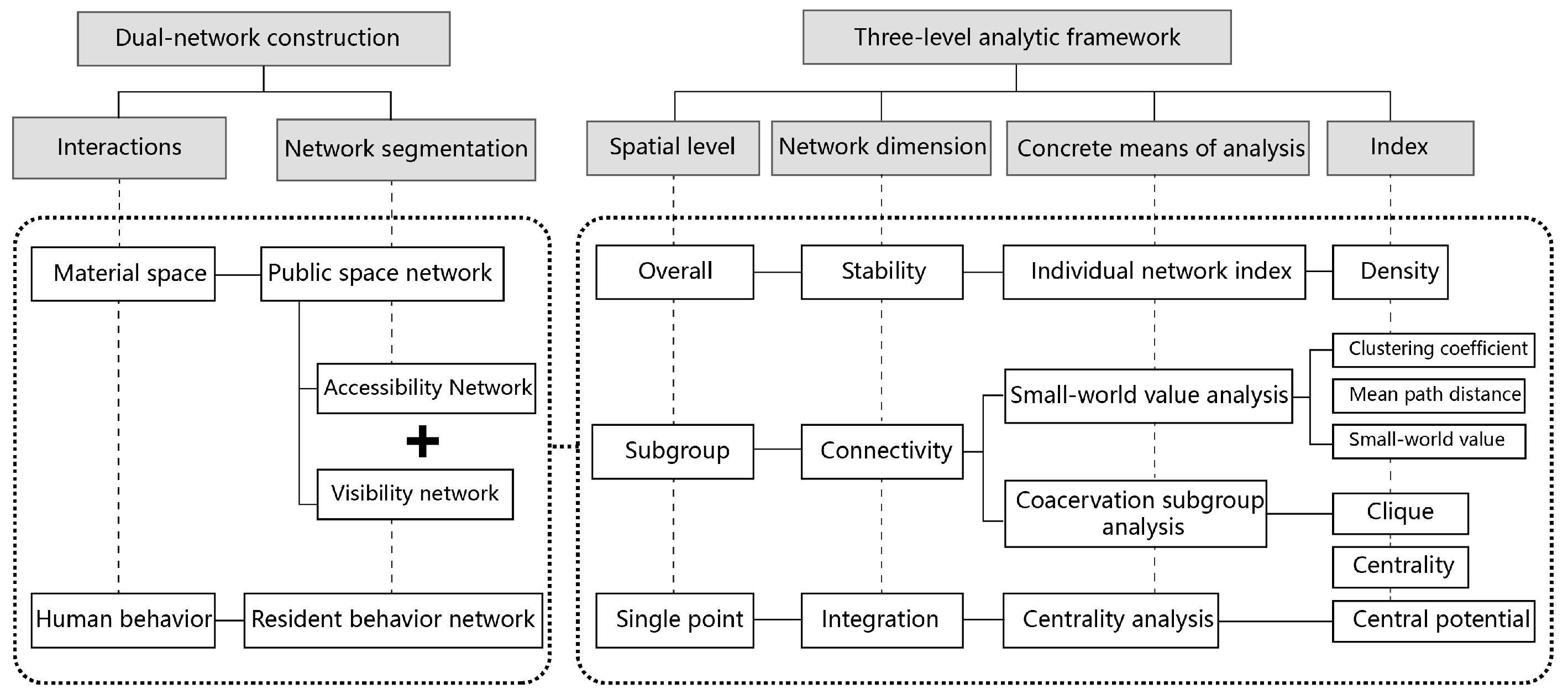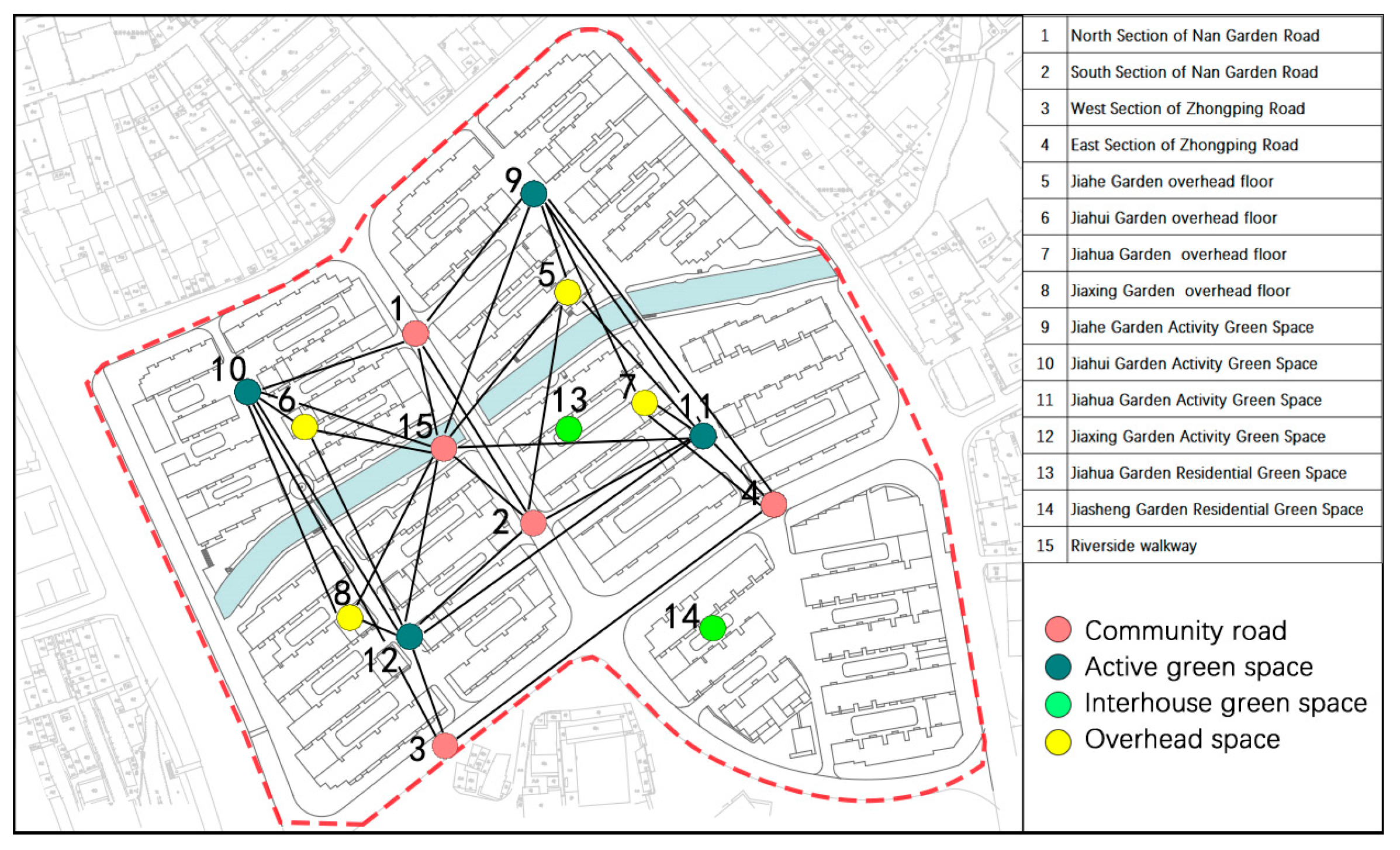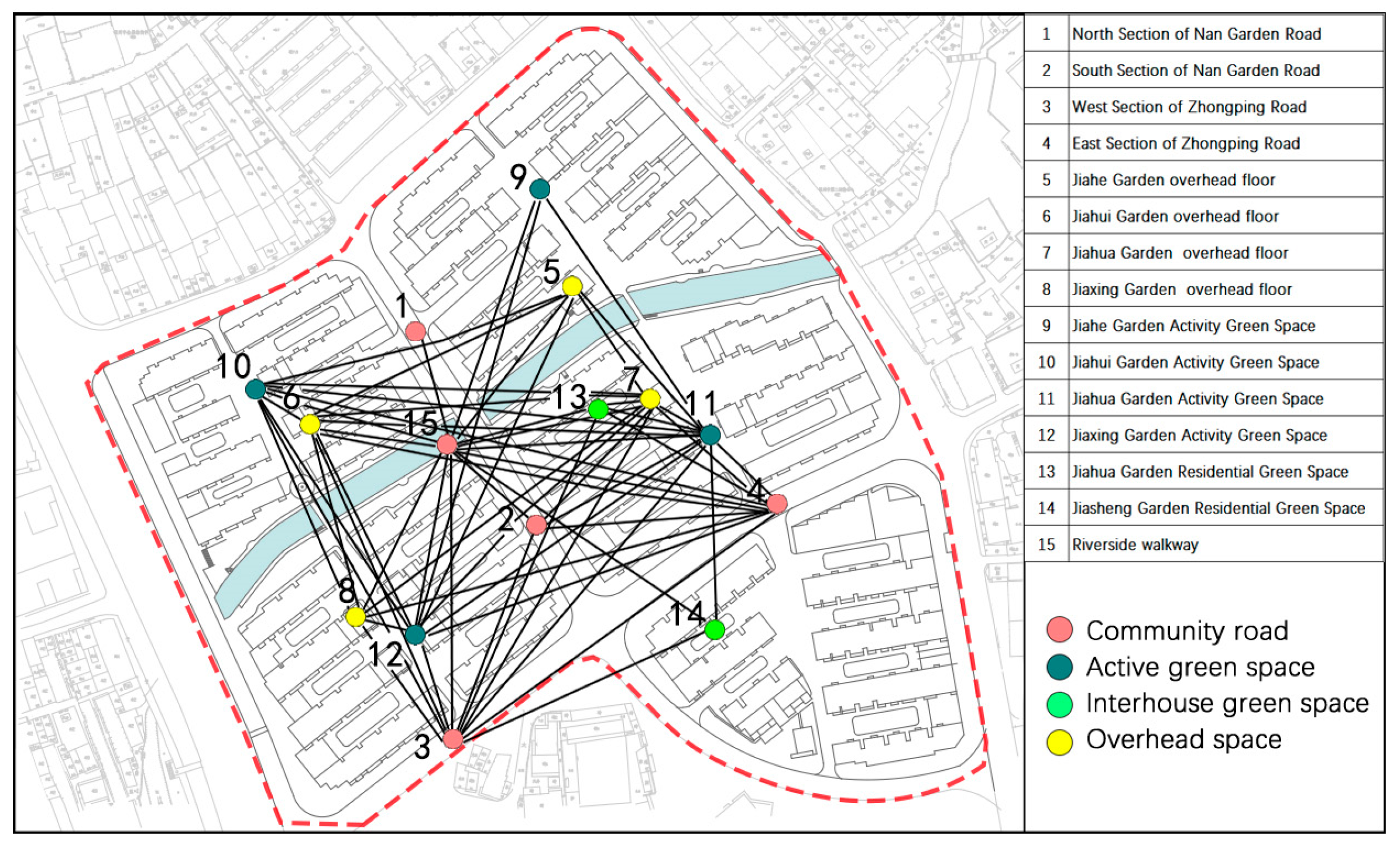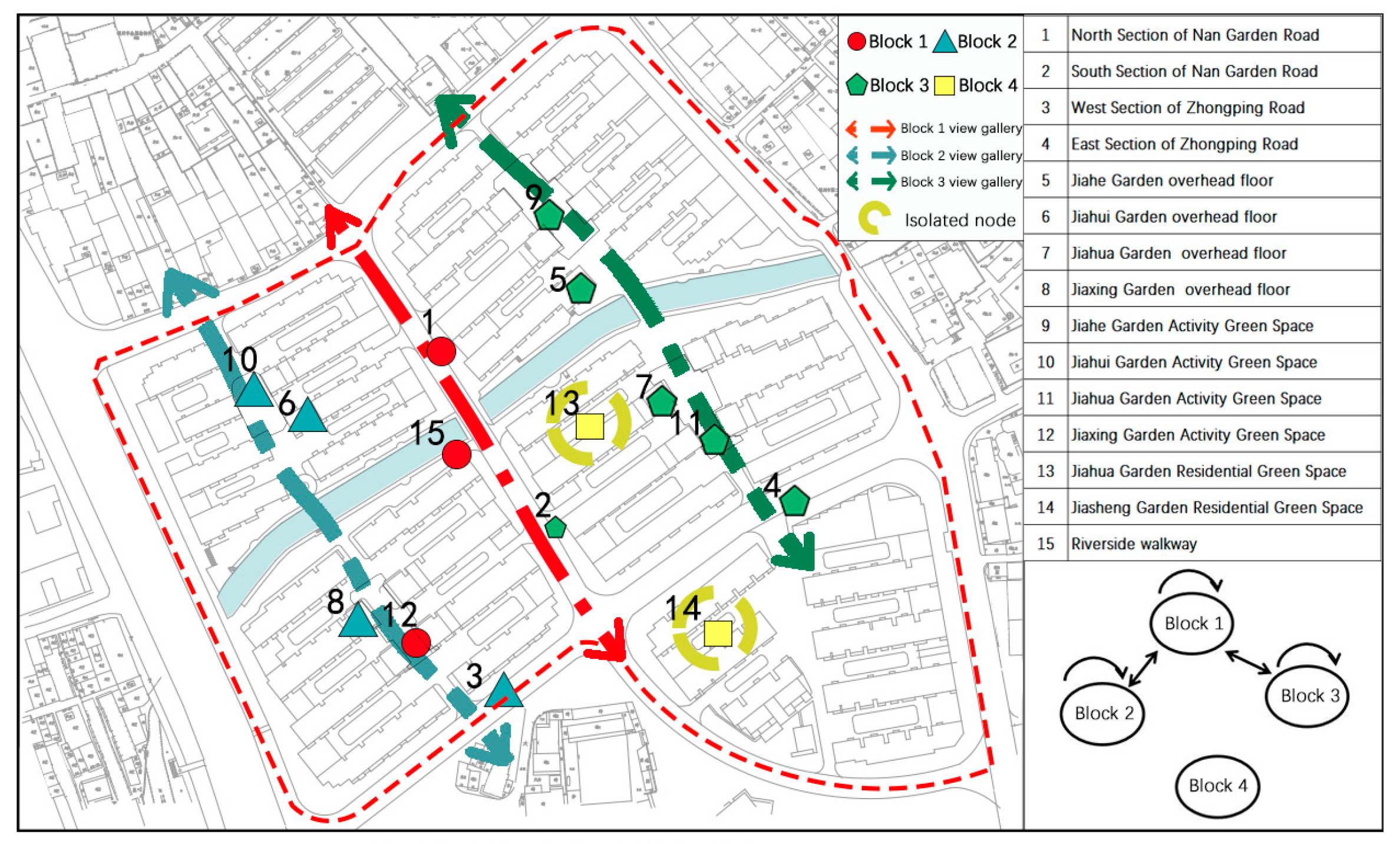Construction and Analysis of Social Structure Model of Public Space in Fuzhou Cangxia Community from Dual Network Perspective
Abstract
1. Introduction
2. Materials and Methods
2.1. Research Cases
- Basic Category: Focused on safety and essential living guarantees, this category includes upgrades to municipal facilities such as water supply, power supply, roads, and fire safety, as well as repairs to public areas of buildings.
- Improvement Category: Emphasizing convenience and functional optimization, this category covers environmental improvements, energy-saving renovations, elevator installations, and the addition of parking and charging facilities.
- Enhancement Category: Aimed at quality improvement and service expansion, this category prioritizes the construction of public service facilities such as education, healthcare, and elderly care, as well as the promotion of smart community upgrades.
- (1)
- Typicality of Community Space
- (2)
- Exemplary Nature of Community Transformation
2.2. Data Source and Processing
2.2.1. Community Data
2.2.2. Network Node Data
2.2.3. Spatial Network Data
2.2.4. Behavioral Network Data
2.3. Research Procedure
3. Results
3.1. Network Model Generation
- (1)
- Spatial Accessibility Network (Na1)
- (2)
- Spatial Visibility Network (Na2)
- (3)
- Resident Behavior Network (Nb)
3.2. Overall Level: Network Stability Analysis
3.3. Subgroup Level: Network Connectivity Analysis
- Subgroup 1 members are concentrated in Jiahui Garden and Jiahe Garden.
- Subgroup 3 members are clustered in Jiahua Garden and Jiasheng Garden.
- Subgroup 4 members are located in Jiaxing Garden.
- Subgroup 1 members are concentrated along major roads.
- Subgroup 2 members span Jiahui Garden and Jiaxing Garden.
- Subgroup 3 members cover Jiahe Garden and Jiahua Garden.
- Subgroup 4 corresponds to residential green spaces.
- Subgroup 1 members are located along primary roads.
- Subgroup 2 members are geographically scattered with low node degrees.
- Subgroup 3 members cluster around Jiahua Garden and Zhongxi Road.
- Subgroup 4 members focus on Jiahui Garden and Jiaxing Garden.
3.4. Single Point Level: Network Integration Analysis
3.5. Space Network-Behavior Network Coupling Analysis
3.5.1. At the Overall Level
3.5.2. At the Subgroup Level
3.5.3. At the Single-Point Level
4. Discussion
4.1. Spatial Network Dual-Attribute Analysis
4.2. Factors Influencing Network Misalignment
4.2.1. Defects in Spatial Structure
4.2.2. Impact of Demographic Characteristics
4.2.3. Limitations of Planning Policies
4.2.4. Catalysis of the Neighborhood Effect
4.3. Enhancement Strategies
- (1)
- By optimizing the overall structure of community roads and adding pathways for residents’ activities, we can improve accessibility throughout the community. For instance, removing the closed fence between Jiahua Garden and Jiaxing Garden and introducing a pedestrian path will strengthen connections between these areas. Additionally, widening the roads and enhancing the pedestrian street environment will encourage residents to engage in more travel and activities within the community.
- (2)
- Increasing the number of visual signs within the community will provide residents with better orientation and enhance overall visibility. For example, well-planned guide signs, such as maps and directional indicators, should align with the community’s layout and functional areas. Ensuring these signs are clearly visible will prevent human factors from diminishing their effectiveness.
- (3)
- Softening the boundaries between community groups can enhance relationships and strengthen functional connections. For example, expanding shared spaces between Jiahui Garden and Jiahe Garden will encourage interaction. By introducing community activity green spaces and sports facilities, as well as regularly organizing community interest activities, we can promote public participation and foster a sense of belonging within the community.
- (4)
- Improving the spatial quality of community nodes by adding activity facilities and optimizing the environment will increase their vibrancy. For example, equipping the overhead floor space of unit buildings with chess tables, seating for children, and other recreational facilities will encourage residents to engage in activities. Regular maintenance of community green spaces will enhance the environment, and adding seating areas will strengthen community bonds and enrich the interactive experience.
- (5)
- Establishing a feedback management mechanism for residents, along with adding community service centers and online platforms (such as WeChat group chats), will facilitate timely solutions to residents’ concerns. In areas with low participation and satisfaction, we can encourage residents to engage in community planning and revitalization through meetings and workshops. This involvement will help improve the community’s overall condition, enhance resident satisfaction, and strengthen social networks within the community.
4.4. Limitations and Future Directions
5. Conclusions
Author Contributions
Funding
Data Availability Statement
Conflicts of Interest
References
- van Bortel, G.; Elsinga, M. A Network Perspective on the Organization of Social Housing in the Netherlands: The Case of Urban Renewal in The Hague. Hous. Theory Soc. 2007, 24, 32–48. [Google Scholar] [CrossRef]
- Nations, U. United Nations Conference on Human Settlements—Habitat I. Available online: https://www.un.org/en/conferences/habitat/vancouver1976 (accessed on 18 December 2024).
- Nations, U. United Nations Conference on Human Settlements—Habitat II. Available online: https://www.un.org/en/conferences/habitat/istanbul1996 (accessed on 18 December 2024).
- Nations, U. Transforming Our World: The 2030 Agenda for Sustainable Development. Available online: https://digitallibrary.un.org/record/803352?v=pdf#files (accessed on 20 December 2024).
- China, The People's Government of the People's Republic. The Central Economic Work Conference Was Held in Beijing. Available online: https://www.gov.cn/xinwen/2019-12/12/content_5460670.htm (accessed on 21 December 2024).
- China, The People's Government of the People's Republic. The Outline of the 14th Five-Year Plan and the Long-Range Objectives Through the Year 2035. Available online: https://www.gov.cn/xinwen/2021-03/13/content_5592681.htm (accessed on 21 December 2024).
- Liang, S.; Leng, H. Residents’ seasonal behavior patterns and spatial preferences in public open spaces of severely cold regions: Evidence from Harbin, China. Habitat Int. 2025, 156, 103279. [Google Scholar] [CrossRef]
- Dong, X.; Zhang, X.; Jing, Y.; Zhou, Q.; Bai, L.; Du, S. Does every public open space (POS) contribute to sustainable city development? An assessment of inefficient POS in Beijing. Sustain. Cities Soc. 2024, 117, 105980. [Google Scholar] [CrossRef]
- Feng, L.; Wang, J.; Liu, B.; Hu, F.; Hong, X.; Wang, W. Does Urban Green Space Pattern Affect Green Space Noise Reduction? Forests 2024, 15, 1719. [Google Scholar] [CrossRef]
- Chu, S.; Weizhen, X.; Danyin, Z.; Jingsong, L.; Jiang, L.; Shuhu, L.; and Hong, X.-C. Urban Blue-Green Spaces and tranquility: A comprehensive review of noise reduction and sensory perception integration. J. Asian Archit. Build. Eng. 2025, 1–22. [Google Scholar] [CrossRef]
- Nasution, A.D.; Zahrah, W. Community Perception on Public Open Space and Quality of Life in Medan, Indonesia. Procedia—Soc. Behav. Sci. 2014, 153, 585–594. [Google Scholar] [CrossRef]
- Villanueva, K.; Badland, H.; Hooper, P.; Koohsari, M.J.; Mavoa, S.; Davern, M.; Roberts, R.; Goldfeld, S.; Giles-Corti, B. Developing indicators of public open space to promote health and wellbeing in communities. Appl. Geogr. 2015, 57, 112–119. [Google Scholar] [CrossRef]
- Ismail, W.A.W.; Said, I. Integrating the Community in Urban Design and Planning of Public Spaces: A Review in Malaysian Cities. Procedia—Soc. Behav. Sci. 2015, 168, 357–364. [Google Scholar] [CrossRef][Green Version]
- Aghazadeh, S.A. Exploring leisure and municipal government public relations for community: A case example of parks and recreation. Public Relat. Rev. 2024, 50, 102410. [Google Scholar] [CrossRef]
- Wang, W.; Xu, C.; Lin, Z. The Renewal of Old Community Public Space in the Context of Social Network: A Case Study of Xingang Community in Fuzhou. New Archit. 2022, 3, 112–116. (In Chinese) [Google Scholar]
- Nugroho, A.G.; Herwangi, Y.; Ogawa, K. Will gated community affect public transit service coverage? Transp. Res. Interdiscip. Perspect. 2024, 24, 101050. [Google Scholar] [CrossRef]
- Su, Y.Q.; Zhang, X.Y.; Chen, X.H. How to alleviate alienation from the perspective of urban community public space-Evidence from urban young residents in China. Habitat Int. 2023, 138, 102836. [Google Scholar] [CrossRef]
- Russell Bernard, H. The Development of Social Network Analysis: A Study in the Sociology of Science, Linton C. Freeman, Empirical Press, Vancouver, BC (2004). Soc. Netw. 2005, 27, 377–384. [Google Scholar] [CrossRef]
- Scott, J. What is Social Network Analysis? Bloomsbury Academic: London, UK, 2012. [Google Scholar]
- Stanley, B. Middle East city networks and the “new urbanism”. Cities 2005, 22, 189–199. [Google Scholar] [CrossRef]
- Colvin, A. Why the Garden Club Couldn’t Save Youngstown: The Transformation of the Rust Belt; Harvard University Press: Cambridge, MA, USA, 2009. [Google Scholar]
- Kleit, R.G. The role of neighborhood social networks in scattered-site public housing residents’ search for jobs. Hous. Policy Debate 2001, 12, 541–573. [Google Scholar] [CrossRef]
- Wellman, B. The Community Question: The Intimate Networks of East Yorkers. Am. J. Sociol. 1979, 84, 1201–1231. [Google Scholar] [CrossRef]
- Bridge, G. The Neighbourhood and Social Networks. 2002. Available online: https://www.researchgate.net/publication/238745662_The_Neighbourhood_and_Social_Networks (accessed on 23 April 2025).
- Piselli, F. Communities, Places, and Social Networks. Am. Behav. Sci. 2007, 50, 867–878. [Google Scholar] [CrossRef]
- Jia, X.; Yan, B.; Fang, L.; Wang, J.; Pang, S.; Liu, Y.; Xu, M. Comparative analysis of urban underground public space and user walking paths based on the social network model. Neural Comput. Appl. 2023, 35, 24981–24999. [Google Scholar] [CrossRef]
- Song, J.; Zhu, Y.; Chu, X.; Yang, X. Research on the Vitality of Public Spaces in Tourist Villages through Social Network Analysis: A Case Study of Mochou Village in Hubei, China. Land 2024, 13, 359. [Google Scholar] [CrossRef]
- Pudjajana, A.M.; Manongga, D.; Iriani, A.; Purnomo, H.D. Identification of Influencers in Social Media using Social Network Analysis (SNA). In Proceedings of the 2018 International Seminar on Research of Information Technology and Intelligent Systems (ISRITI), Yogyakarta, Indonesia, 21–22 November 2018; pp. 400–404. [Google Scholar]
- Del-Fresno-García, M.; Daly, A.; Segado, S. Identifying the new Influencers in the Internet Era: Social Media and Social Network Analysis. Reis. 2016. Available online: https://www.academia.edu/20223007/Identifying_the_new_Influencers_in_the_Internet_Era_Social_Media_and_Social_Network_Analysis (accessed on 23 April 2025).
- Zhang, P.F.; Zhao, Y.Y.; Zhu, X.H.; Cai, Z.W.; Xu, J.X.; Shi, S. Spatial structure of urban agglomeration under the impact of high-speed railway construction: Based on the social network analysis. Sustain. Cities Soc. 2020, 62, 102404. [Google Scholar] [CrossRef]
- Halder, A. Social network analysis of stakeholder governance landscapes in infrastructure mega projects: A case of the Delhi-Mumbai Industrial Corridor project. Innov. Infrastruct. Solut. 2024, 9, 209. [Google Scholar] [CrossRef]
- Shi, Y.L.; Huang, Y.; Hu, D.Y.; Wan, D. Evaluation of social network conservation in historical areas of mountainous towns in Chongqing, China. J. Mt. Sci. 2020, 17, 1763–1775. [Google Scholar] [CrossRef]
- Chen, J.Y.; Chang, Z. Rethinking urban green space accessibility: Evaluating and optimizing public transportation system through social network analysis in megacities. Landsc. Urban Plan. 2015, 143, 150–159. [Google Scholar] [CrossRef]
- Chen, X.; Zhang, Y.; Hu, X. Analysis of Regional Freeway Traffic Safety Based on Social Network. 2020. Available online: https://ascelibrary.org/doi/10.1061/9780784483053.220 (accessed on 23 April 2025).
- Raj, U.; Banerjee, A.; Ray, S.; Bhattacharya, S. Structure of higher-order interactions in social-ecological networks through Q-analysis of their neighbourhood and clique complex. PLoS ONE 2024, 19, e0306409. [Google Scholar] [CrossRef]
- Gan, C.; Voda, M.; Wang, K.; Chen, L.; Ye, J. Spatial network structure of the tourism economy in urban agglomeration: A social network analysis. J. Hosp. Tour. Manag. 2021, 47, 124–133. [Google Scholar] [CrossRef]
- Xiang, H.; Xie, M.; Fang, Y. Study on the architecture space-social network characteristics based on social network analysis: A case study of Anshun Tunpu settlement. Ain Shams Eng. J. 2024, 15, 102333. [Google Scholar] [CrossRef]
- Liu, Z.; Wang, S.; Wang, F. Isolated or integrated? Planning and management of urban renewal for historic areas in Old Beijing city, based on the association network system. Habitat Int. 2019, 93, 102049. [Google Scholar] [CrossRef]
- Li, Q.; Lv, S.; Cui, J.; Liu, Y.; Chen, Z. Research on the Public Environment Renewal of Traditional Villages Based on the Social Network Analysis Method. Sustainability 2024, 16, 1006. [Google Scholar] [CrossRef]
- Lin, J.; Hu, J.; Tang, R.; Cui, J. Cluster spatial identification of traditional villages under social solidarity: From the perspective of contiguous protection. J. Cent. China Norm. Univ. Nat. Sci. Ed. 2024, 58, 359–370. [Google Scholar]
- Yan, B.; Xu, M. Research on the Construction of Network Cognitive Feedback Model in Historical and Cultural Space:A Case Study of Tangjiawan Ancient Town in Zhuhai. J. Hum. Settl. West China 2023, 38, 89–95. [Google Scholar]
- Shi, Y.; Huang, Y.; Yang, L.; Li, J. the Commercialization Mechanism of Traditional Settlements from the Perspective of Social Network Evolution: An Example of Ancient Towns in Southwest China. Urban Stud. 2023, 30, 133–144. [Google Scholar]
- Zhao, J.; Peng, Z.H.; Liu, L.B.; Yu, Y.; Shang, Z.R. Public Space Layout Optimization in Affordable Housing Based on Social Network Analysis. LAND 2021, 10, 955. [Google Scholar] [CrossRef]
- Liu, Q.; Hao, W.; Xia, M. Spatial association of coastal towns and villages in Funing District, Qinhuangdao: A study using social network analysis. J. Rural Stud. 2024, 107, 103261. [Google Scholar] [CrossRef]
- Hawken, S.; Sunindijo, R.Y.; Sanderson, D. The critical role of community networks in building everyday resilience—Insights from the urban villages of Surabaya. Int. J. Disaster Risk Reduct. 2023, 98, 104090. [Google Scholar] [CrossRef]
- He, Z.; He, J.; Chen, X. Community public space under network thinking: An analysis of the effectiveness of community public space in Jiefang Middle Road, Yuexiu District, Guangzhou. New Archit. 2014, 4, 102–106. (In Chinese) [Google Scholar]
- Song, J.; Chen, J.; Hu, Y. Spatial Transformation Strategy of Industrial Heritage from the Perspective of Social Network Analysis: A Case Study of Sanlinqiao Community Center Project. South Archit. 2024, 3, 32–41. (In Chinese) [Google Scholar]
- Lin, G.; Yu, X.; Li, Y. Social network dynamics in rural public spaces of multi-ethnic settlements: A case study from Tongren, China. Alex. Eng. J. 2024, 102, 132–148. [Google Scholar] [CrossRef]
- Luo, Y.; Lai, B.; Zhang, Y.; Liu, J. Village leadership, social networks and collective actions in indigenous communities: Case of Hani rice terrace social-ecological system in Southwest China. J. Rural Stud. 2024, 106, 103237. [Google Scholar] [CrossRef]
- Barnett, D.W.; Barnett, A.; Nathan, A.; Van Cauwenberg, J.; Cerin, E. Built environmental correlates of older adults’ total physical activity and walking: A systematic review and meta-analysis. Int. J. Behav. Nutr. Phys. Act. 2017, 14, 103. [Google Scholar] [CrossRef]
- Park, S.; Roh, S.; Yeo, I. Analysis of the Liner Shipping Network Structure of the Asia–Europe Main Trunk Route Using Social Network Analysis. Sustainability 2024, 16, 7414. [Google Scholar] [CrossRef]
- Vervoort, P.; Vanderheiden, S.; Hambsch, L.; Poelmans, L.; Vandermoere, F.; Loots, I. Greenness visibility in urban living environments as pathway to promote health and well-being: Mapping spatial differentiation in Flanders (Belgium) based on viewshed analysis. Nat.-Based Solut. 2024, 6, 100187. [Google Scholar] [CrossRef]
- Le, Q.H.; Kwon, N.; Nguyen, T.H.; Kim, B.; Ahn, Y. Sensing perceived urban stress using space syntactical and urban building density data: A machine learning-based approach. Build. Environ. 2024, 266, 112054. [Google Scholar] [CrossRef]
- Qi, L.; Hu, Y.; Bu, R.; Xiong, Z.; Li, B.; Zhang, C.; Liu, H.; Li, C. Spatial-temporal patterns and influencing factors of the Building Green View Index: A new approach for quantifying 3D urban greenery visibility. Sustain. Cities Soc. 2024, 111, 105518. [Google Scholar] [CrossRef]
- Muñoz, C.A.M.; Ramos, F.J.M. Informal / formal morphogenesis in Latin American settlements: A response to the problem of urban fragmentation. J. Urban Manag. 2024, 13, 497–520. [Google Scholar] [CrossRef]
- Nouri, M.; Chaudhury, H. Individual and Neighborhood Characteristics of Walking Activity in People Living With Dementia: A Proof of Concept for Quantitative Spatial Analysis. J. Aging Phys. Act. 2025, 1–16. [Google Scholar] [CrossRef] [PubMed]
- Lindström, M. Social capital, desire to increase physical activity and leisure-time physical activity: A population-based study. Public Health 2011, 125, 442–447. [Google Scholar] [CrossRef]
- Kim, J.-R.; Jeong, B.; Park, K.-S.; Kang, Y.-S. Association of social capital at the individual level with physical activity in communities with high mortality in Korea. Health Promot. Int. 2017, 32, 850–859. [Google Scholar] [CrossRef]
- Fu, C.; Wang, C.; Yang, F.; Cui, D.; Wang, Q.; Mao, Z. Association between social capital and physical activity among community-dwelling elderly in Wuhan, China. Int. J. Gerontol. 2018, 12, 155–159. [Google Scholar] [CrossRef]
- Islam, M.K.; Merlo, J.; Kawachi, I.; Lindström, M.; Gerdtham, U.G. Social capital and health: Does egalitarianism matter? A literature review. Int. J. Equity Health 2006, 5, 3. [Google Scholar] [CrossRef]
- Liu, P.; Qin, Y.; Luo, Y.; Wang, X.; Guo, X. Structure of low-carbon economy spatial correlation network in urban agglomeration. J. Clean. Prod. 2023, 394, 136359. [Google Scholar] [CrossRef]
- Liang, Z.; Chen, J.; Jiang, D.; Sun, Y. Assessment of the spatial association network of green innovation: Role of energy resources in green recovery. Resour. Policy 2022, 79, 103072. [Google Scholar] [CrossRef]
- Chase, A.S.Z. Reconstructing and testing neighborhoods at the Maya city of Caracol, Belize. J. Anthropol. Archaeol. 2023, 70, 101514. [Google Scholar] [CrossRef]
- Kamp-Whittaker, A. Social networks and community features: Identifying neighborhoods in a WWII Japanese American incarceration center. J. Anthropol. Archaeol. 2023, 70, 101507. [Google Scholar] [CrossRef]








| Network Dimension | Evaluation Index | Calculation Formula | Formula Specification |
|---|---|---|---|
| Overall | Density | P is the network density, m is the actual number of connections, and n is the actual number of nodes. | |
| Subgroup | Clustering coefficient | Cx is the number of connections that actually exist in these y nodes, and n is the number of nodes in the network. | |
| Average path length | The shortest path distance between nodes a and b is dab, n represents the number of nodes, and L represents the average path length. | ||
| Small-world value | C is the average aggregation coefficient of the network, Cr is the aggregation coefficient of a random network of the same size, L is the average shortest path length of the network, and Lr is the shortest path length of a random network of the same size. | ||
| Block model | is the average number of relations directed to node j, and k is the number of nodes in the entire network. | ||
| Single point | Node degree | d(ni) Indicates the number of nodes that directly generate a line segment connected to the node, n indicates the total number of nodes in the entire network. | |
| Intermediate centrality | CABi = ΣnΣn b (i), j ≠ k ≠ i, j < k | CABi is the middle centrality of the network. b is the probability that node i is on the shortest path between node j and node k, and n is the number of nodes. | |
| Intermediate central potential | CB =Σ (CRB max − CRB i) /n − 1 | n represents the number of nodes, CB represents the center potential of the middle of the network, CRB i represents the centrality of the node relative to the middle, and CRB max represents the maximum centrality of the node relative to the middle. |
| Network Dimension | Evaluation Index | Numerical Result |
|---|---|---|
| Integration | Node degree | In Table 6 |
| Intermediate centrality | In Table 7 | |
| Intermediate central potential | 0.5549 | |
| Connectivity | Clustering coefficient | 0.715 |
| Average path length | 1.933 | |
| Small-world value | 1.239 | |
| Block model | In Figure 6 | |
| Stability | Density | 0.305 |
| Network Dimension | Evaluation Index | Numerical Result |
|---|---|---|
| Integration | Node degree | In Table 6 |
| Intermediate centrality | In Table 7 | |
| Intermediate central potential | 0.4615 | |
| Connectivity | Clustering coefficient | 0.61 |
| Average path length | 1.615 | |
| Small-world value | 1.266 | |
| Block model | In Figure 7 | |
| Stability | Density | 0.314 |
| Network Dimension | Evaluation Index | Numerical Result |
|---|---|---|
| Integration | Node degree | In Table 6 |
| Intermediate centrality | In Table 7 | |
| Intermediate central potential | 0.4945 | |
| Connectivity | Clustering coefficient | 0.851 |
| Average path length | 1.438 | |
| Small-world value | 1.983 | |
| Block model | In Figure 8 | |
| Stability | Density | 0.562 |
| Mean Shortest Path | Clustering Coefficient | Small-World Value | Is Not Small World Characteristic | |
|---|---|---|---|---|
| Nb network | 1.438 | 0.851 | 1.983 | Yes |
| Na1 network | 1.933 | 0.715 | 1.239 | No |
| Na2 network | 1.615 | 0.610 | 1.266 | No |
| 100 random networks | 1.595 | 0.476 | / |
| Spatial Nodes | Nb | Na1 | Na2 |
|---|---|---|---|
| Node 15 | 14 | 11 | 10 |
| Node 11 | 13 | 5 | 7 |
| Node 3 | 11 | 4 | 3 |
| Node 7 | 11 | 5 | 4 |
| Node 4 | 10 | 5 | 4 |
| Node 12 | 10 | 4 | 7 |
| Node 6 | 9 | 3 | 3 |
| Node 10 | 9 | 3 | 6 |
| Node 8 | 8 | 3 | 3 |
| Node 5 | 6 | 3 | 4 |
| Node 2 | 5 | 6 | 5 |
| Node 13 | 5 | 3 | 0 |
| Node 9 | 3 | 3 | 6 |
| Node 14 | 3 | 1 | 0 |
| Node 1 | 1 | 5 | 4 |
| Average | 7.867 | 4.267 | 4.4 |
| Spatial Nodes | Nb | Na1 | Na2 |
|---|---|---|---|
| Node 15 | 22.967 | 53.095 | 17.917 |
| Node 11 | 9.967 | 5.619 | 5.75 |
| Node 3 | 4.467 | 3.333 | 2.167 |
| Node 7 | 2.967 | 5.619 | 0.667 |
| Node 12 | 2.833 | 2.476 | 7.333 |
| Node 4 | 1.8 | 14.286 | 2.833 |
| Node 10 | 0.5 | 0 | 4.667 |
| Node 6 | 0.5 | 0 | 0 |
| Node 14 | 0 | 0 | 0 |
| Node 13 | 0 | 0 | 0 |
| Node 9 | 0 | 0 | 3.833 |
| Node 8 | 0 | 2.143 | 0 |
| Node 5 | 0 | 0 | 0.25 |
| Node 2 | 0 | 9.429 | 1.5 |
| Node 1 | 0 | 2 | 1.083 |
| Average | 3.067 | 6.533 | 3.200 |
Disclaimer/Publisher’s Note: The statements, opinions and data contained in all publications are solely those of the individual author(s) and contributor(s) and not of MDPI and/or the editor(s). MDPI and/or the editor(s) disclaim responsibility for any injury to people or property resulting from any ideas, methods, instructions or products referred to in the content. |
© 2025 by the authors. Licensee MDPI, Basel, Switzerland. This article is an open access article distributed under the terms and conditions of the Creative Commons Attribution (CC BY) license (https://creativecommons.org/licenses/by/4.0/).
Share and Cite
Wang, W.; Cao, M.; Wu, Z.; Hong, X. Construction and Analysis of Social Structure Model of Public Space in Fuzhou Cangxia Community from Dual Network Perspective. Buildings 2025, 15, 1473. https://doi.org/10.3390/buildings15091473
Wang W, Cao M, Wu Z, Hong X. Construction and Analysis of Social Structure Model of Public Space in Fuzhou Cangxia Community from Dual Network Perspective. Buildings. 2025; 15(9):1473. https://doi.org/10.3390/buildings15091473
Chicago/Turabian StyleWang, Wei, Mingkang Cao, Zhigang Wu, and Xinchen Hong. 2025. "Construction and Analysis of Social Structure Model of Public Space in Fuzhou Cangxia Community from Dual Network Perspective" Buildings 15, no. 9: 1473. https://doi.org/10.3390/buildings15091473
APA StyleWang, W., Cao, M., Wu, Z., & Hong, X. (2025). Construction and Analysis of Social Structure Model of Public Space in Fuzhou Cangxia Community from Dual Network Perspective. Buildings, 15(9), 1473. https://doi.org/10.3390/buildings15091473






